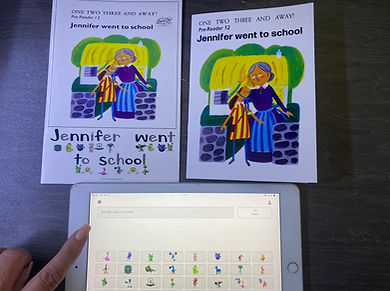Code Mapping® is our unique visual mapping of graphemes within the Speech Sound Pics (SSP) Approach, and Monster Mapped® Words also show the sound value, making English orthography accessible for neurodivergent learners.

Monster Mapped 1,2, 3 and Away! Books
The first 52 books in the One, Two, Three and Away series, including the 36 pre-readers and 16 introductory readers, are Code and Monster Mapped®, with Phonemies®.
Phonemies® - Speech Sound Monsters - show the sound value of each letter or letter string (grapheme), reducing the cognitive load required to work out the words. This is especially helpful when grapheme–phoneme correspondences are unfamiliar (not yet taught - or not included in a systematic phonics programme) or when the child has weak phonemic awareness and limited phonological working memory. We use these at the Early Dyslexia Screening Centre.
The Story People Pegs and beautifully illustrated stories capture the imagination and help children become emotionally invested in reading, rather than viewing it as just a decoding task.
Reading for pleasure the goal. Please help us get the books into libraries so that children can borrow them for home use after reading the mapped versions at school. Libraries can order them through Gardners. There are currently 36 pre-readers, 16 introductory readers, 20 blue books and 20 main readers. 10 red, 10 yellow and 10 green platform readers launching soon!



The books are the classic One, Two, Three and Away! series by Sheila McCullagh, published by The Reading Hut Ltd and available to libraries through Askews, Gardners, and other major suppliers.
Please download the pdf and ask your local library to stock a set so more children can enjoy them. Here they are on display in Surrey!
Orthographic Learning with Monster Mapped Books



Use the Phonemies® to assist with discovery phonics by supporting understanding of grapheme–phoneme correspondences not explicitly taught in the Core Code or tested in the Phonics Screening Check. They also support blending phonemes and phonological working memory, reducing cognitive load. This activity targets the underlying challenges faced by dyslexic learners.
Also do this in reverse. You are again supporting the understanding of grapheme–phoneme correspondences not explicitly taught in the Core Code (see SSP) or tested in the Phonics Screening Check, but this time in reverse, for spelling.
Support the identification of phonemes, segmenting, and blending by asking the child to recreate the sentence using MySpeekie® in MyWordz.tech, or in the app.
This activity is one of the most effective ways to overcome the underlying challenges faced by dyslexic learners.

Start constructing words from speech to print before children are even forming letters or mark making.
The focus is on organising the speech sounds in the correct order, and they are shown the representations (the graphemes). This reduces cognitive load and removes the need to know specific grapheme–phoneme correspondences to create sentences. This is empowering for children, as they are not held back by the limitations of explicit instruction. They are also addressing phonemic awareness and phonological working memory difficulties, both of which severely hinder orthographic learning for dyslexic minds.
Common Exception / Irregular Words : The Code Shown
Recoding is the process of using knowledge of letter–sound relationships to access the phonological form of a known spoken word from its written form. While children can often figure out words when reading, even if they cannot decode the whole word, they need to recode it in order to secure the word in the brain’s word bank, known as the orthographic lexicon. This is essential for developing reading fluency and confident spelling. To achieve orthographic mapping, children must connect letters and sounds in both directions — from print to speech, and from speech to print. Orthographic mapping is currently the most widely accepted theory explaining how children learn to read and spell. Dyslexic learners may learn to read reasonably well but often continue to struggle with spelling, as they need the mapping of words to be securely stored for instant recognition and quick retrieval when writing. Use MyWordz® to show the code in both directions, and to blend the sounds for dyslexic learners who need more support to make those connections.
MyWordz® Buy the tech for £75! https://MyWordz.tech
Order Monster Mapped Books here shortly
Order the regular set of Pre-Readers from The Reading Hut Ltd














